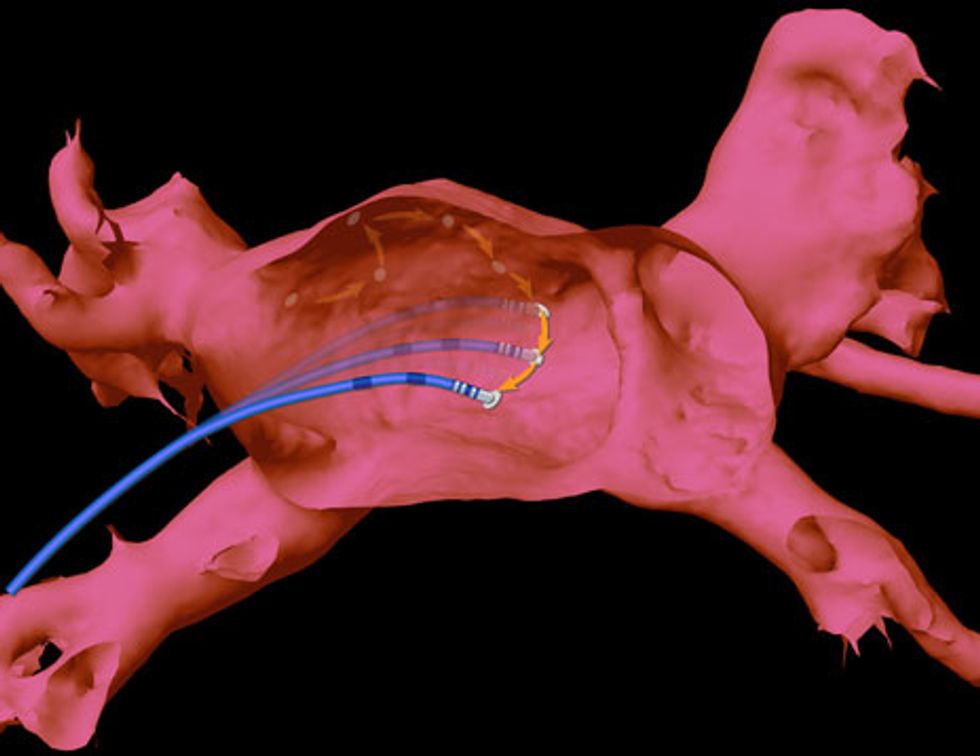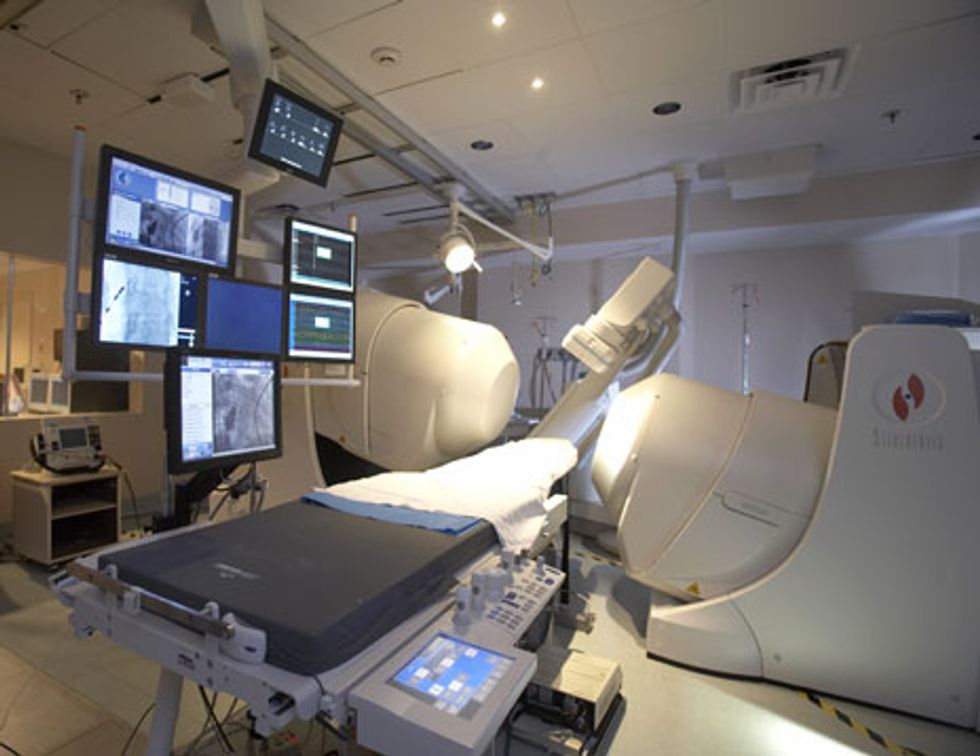9 June 2009—Would you put your heart in the hands of a robot? What if you had a severely impaired heart, afflicted with an unpredictable rhythm, which could be treated only by lacing a catheter through the delicate avenues of your vasculature and up into the atria, where it would sear the tissue and leave a curative scar? Would you want a human hand behind this procedure, or motors, microprocessors, and magnets?
At the scientific sessions for the Heart Rhythm Society last month in Boston, most cardiologists seemed resigned to—and even enthusiastic about—transferring their expertise to robots. After a public debate over the safety and efficacy of the two catheter-guidance systems currently available, the audience of doctors was asked to vote. Only two hands went up in opposition to robots, a signal that early clinical successes and recent design enhancements could soon increase the use of catheter-guidance robots.
The manual approach for these surgeries, known as catheter ablations, requires a tremendous amount of precision and skill. A doctor inserts a rigid but flexible catheter through an artery in the leg and navigates it all the way to the heart. ”You’re trying to drive the back end and steer the tip,” says Rick Green, vice president of marketing for Stereotaxis, a company that supplies cardiology labs with a robot called Niobe.
With the Stereotaxis device, surgeons must still manually guide the catheter through the arteries to the patient’s heart, but once the device is there, the Niobe system uses a set of external magnets to maneuver the metal tip of the catheter. On a fully automated setting, Niobe begins to map the heart chambers, advancing until it bumps up against a wall of a chamber. Each time it stops, the system records a point on the map, and every point that’s added enhances a topographical image of the heart on a computer screen. The surgeon is free to take over at any time and add points where they’re needed.
The cardiologist uses the map and electrophysiological data provided by electrodes in the catheter to determine which area is causing the heart to beat erratically. The doctor can either assign the robot coordinates on the map and let it find its own way there or can control the trajectory of the catheter by changing its vector on the screen. The same catheter then emits radio waves to heat and ablate the tissue.
TAP, TAP, TAP
The catheter heart surgery robot automatically explores a heart chamber, mapping out it's electrical properties and looking for the cause of irregular heart beats.
The active tip and a few thin metal bracelets around the circumference of the catheter are the only rigid parts of the device. Otherwise, it’s like a floppy strand of spaghetti. This characteristic sets it apart from every other catheter available and makes it more difficult to puncture through the heart into the esophagus, a potential complication in catheter ablation.
Because navigation and placement are key to the operation, it’s necessary to periodically apply X-rays to get real-time images of the heart and the catheter as the heart beats. Doctors who manually perform the operation without a robot’s help end up standing half bent over for long stretches, wearing a heavy lead smock. They must carefully monitor their X-ray exposure time.
One of the major benefits of robotic systems is that they can be operated remotely and get the surgeon out of the room and away from the X-rays. Tamas Szili-Torok, a cardiologist at the Thoraxcentre, in Rotterdam, has used Niobe to treat children. He notes that while he did not see a reduction of X-ray exposure to patients, he says he would still use the system ”because the physician has no fluoro[scopy] time.”
Another system, called Sensei, is available from Hansen Medical. This company’s device uses motors to push and bend the catheter much the way a human operator would, but it has benefits of its own. For one thing, it is much less expensive to set up than Niobe, which requires that cardiology labs be fully renovated to shield the rest of the facility from the strong magnetic field that guides the robot.
Oussama Wazni, a cardiologist at the Cleveland Clinic, in Ohio, says that in his experience the Hansen robot is easier to operate, while the floppy Niobe catheter is less prone to complications. However, he has yet to conduct a formal study comparing catheter performance.
Complications have still been reported, and that’s the main problem for cardiologist Nassir Marrouche, of the University of Utah, who argued last week against the use of surgical robots in catheter ablation.
Another cardiologist at the debate, Walid Saliba, from the Cleveland Clinic, explained that most of the complications in his own procedures were part of a natural learning curve and part of the process of figuring out how much force to use with a robotic system. ”It is possible that you don’t need to use as much power as you do with the manual approach,” he says.
Judging by the vote, most doctors present were persuaded by Wazni’s request that we ”don’t blame the robot.” Although these systems could clearly be enhanced, he says, the human operators are the ones with the most to learn.
About the Author
Morgen E. Peck is a freelance writer based in New York City, who recently returned from working on a documentary film in Indonesia. In February 2009, she wrote for IEEE Spectrum Online about the use of electroporation in cancer surgery.


